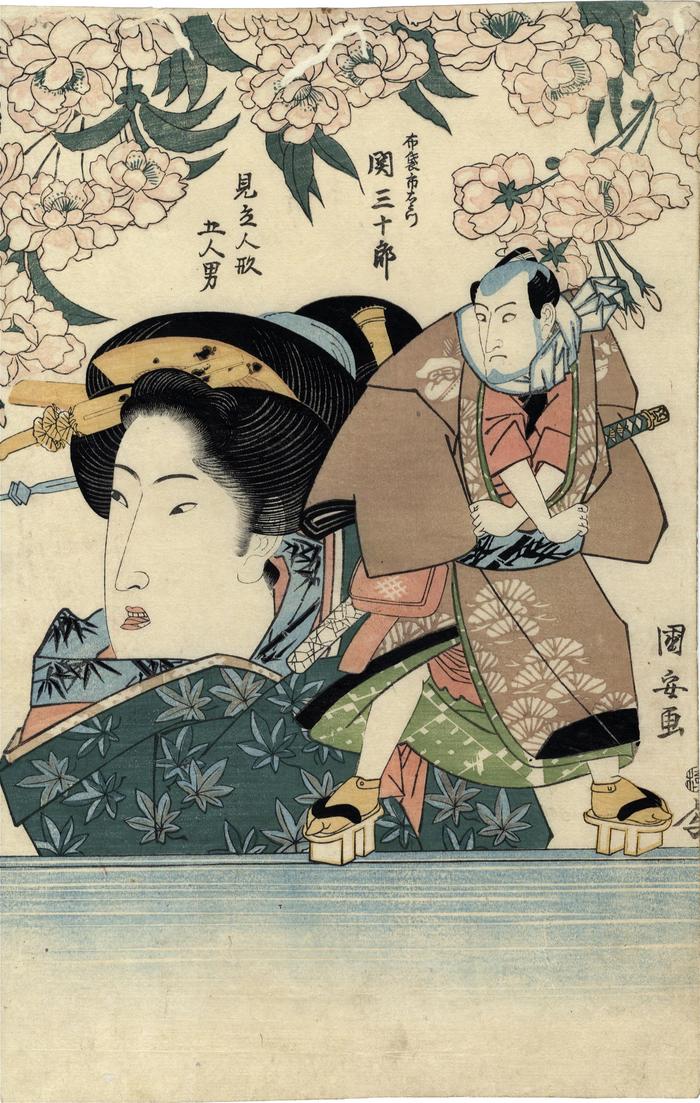Utagawa Kuniyasu (歌川国安) (artist 1794 – 1832)
The puppet the beautiful woman is holding is in the form of Arashi Sanjūrō VII (嵐三十郎) as the otokodate Hotei Ichiemon (布袋市右衛門) from the series 'Five Chivalrous Men as Puppets' (Mitate ningyō gonin otoko - 見立人形五人男)
ca 1827
9.5 in x 14.75 in (Overall dimensions) Japanese color woodblock print
Signed: Kuniyasu ga (国安画)
Publisher: Uemura Yohei (Marks 423 - seal 05-007)
Censor's seal: kiwame
Lyon Collection - the whole pentaptych The real-life Hotei Ichiemon (1673-1702)
Hotei Ichiemon, like all of the men who came to be known as otokodate, was a criminal and a rogue who was glamorized in later lore. "Expelled from father's home and became homeless in 1694. Involved in violent crimes from at least 1697, when he enlisted as a member of a gang that included An no Heibei and Kaitate no Kichiemon. Imprisoned in mid-1697, he received clemency on the twenty-fourth day, First Month, 1698, but thereafter joined Seven's Gang. Imprisoned on the twenty-second day, Eleventh Month, 1701, and beheaded on the twenty-sixth day of the Eighth Month, 1702."
Quoted from: Osaka: The Merchants' Capital of Early Modern Japan in an essay by Gary Leupp, 'The Five Men of Naniwa: Gang Violence and Popular Culture in Genroku Osaka', p. 134. (JSV)
****
How one can tell if you are looking at an image of Hotei Ichiemon or not: it can be in either the designs of the robes or in tattoos on his body.
In an article, 'Osaka tattoos', by Jan van Doesburg in Andon 72 &73, October, 2002, on page 113, the author wrote in reference to a print by Kunikazu: "The name Hotei is associated with wealth and good fortune, which here is emphasized by the presence of the God of Luck on Ichiemon's clothes and by the tattooed tree-peonies that largely cover his shoulders and upper arms. Apart from good luck, the tree-peony is associated with gambling and daredevilry, since the king of flowers made his appearance in the old card game Hana-fuda.It is one of the favourite icons of street knights, but even today the tree-peony is often a part of the Japanese tattoo, if only because oÍ its decorative appeal."
In this print by Kuniyasu in the Lyon Collection the indication that this is Hotei Ichiemon can be found on his clothing. Look at the partial images of bags with accompanying fans found on is shoulders.
beautiful woman picture (bijin-ga - 美人画) (genre)
actor prints (yakusha-e - 役者絵) (genre)
Uemura Yohei (上村与兵衛) (publisher)
Otokodate - chivalrous men (男伊達) (genre)
mitate-e (見立て絵) (genre)
